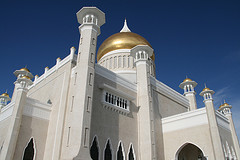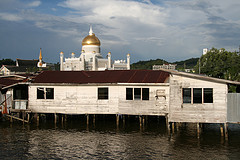Sarawak: Of Orange Babies and Cat Cities
Thursday, March 26th, 2009Leaving Brunei and its hot-water-taps-only behind us, we continued west to Sarawak, stopping first at Miri to visit the Niah Caves. I didn’t think much of the caves myself, and thought it was quite dangerous inside the large cave (think pitch black and slippery with lots of steps, and add kids and grandparents, and you get the idea).
From the caves, we took what will hopefully be our last overnight bus for a while (since we’ll soon re-enter the mythical land of trains in Northeast Asia) to Kuching. The city’s name means ‘cat’ in Bahasa Malaysia, something the city has been trading on for a while judging by the (at least) four monuments in the city with cats on them. Cats aside, Kuching is the nicest town in all of Borneo. It has a colonial core unmatched on the island, and with its distinct Chinese and Indian areas it more closely resembles the cities on the Malay Peninsula than those on Borneo.
Our trip to nearby Bako National Park during the past three days has been the highlight of Sarawak and the second most rewarding destination for us in Malaysian Borneo after Sipadan. Bako is a very well managed park with marked hiking trails and, unusually for these parts, reasonably priced accommodation and food options (no US$85 dorm beds here, thankfully). The park is on the north coast of Borneo and offers a landscape of beaches, cliffs, mangroves and jungle that all merge effortlessly together to form a beautiful setting.
 On the trails and around the park headquarters at Bako we saw plenty of macaques, proboscis monkeys, silver-leaf monkeys and bearded pigs (which are as ugly as you’d think), and half-a-dozen enormous jellyfish washed up on the main beach (more interesting than you’d think). The most enjoyable part was yesterday afternoon when a group of 20+ silver leaf monkeys, who resemble the Indian langur in appearance and movement, came down to the beach and engaged in a spot of gang warfare with the macaques (presumably over the food-scrap territory near the canteen, but I could be mistaken; in any case the rivalry is crying out for one of Animal Planet’s ‘Meerkat Manor’ style documentaries). A few of the silver-leaf monkeys were carrying babies, but only one was young enough to still be bright orange; the others were already as silver as their parents. The orange baby’s mother was extremely protective and we never saw the baby’s face, but I think I got a pretty good shot of the two of them anyway.
On the trails and around the park headquarters at Bako we saw plenty of macaques, proboscis monkeys, silver-leaf monkeys and bearded pigs (which are as ugly as you’d think), and half-a-dozen enormous jellyfish washed up on the main beach (more interesting than you’d think). The most enjoyable part was yesterday afternoon when a group of 20+ silver leaf monkeys, who resemble the Indian langur in appearance and movement, came down to the beach and engaged in a spot of gang warfare with the macaques (presumably over the food-scrap territory near the canteen, but I could be mistaken; in any case the rivalry is crying out for one of Animal Planet’s ‘Meerkat Manor’ style documentaries). A few of the silver-leaf monkeys were carrying babies, but only one was young enough to still be bright orange; the others were already as silver as their parents. The orange baby’s mother was extremely protective and we never saw the baby’s face, but I think I got a pretty good shot of the two of them anyway.
We’re now back in Kuching, with only one more day on Borneo before we fly to Kuala Lumpur tomorrow night. And, with the fourth and final Orang-Utan rehabilitation centre only a bus ride away, it would seem rude not to visit it before we leave…


